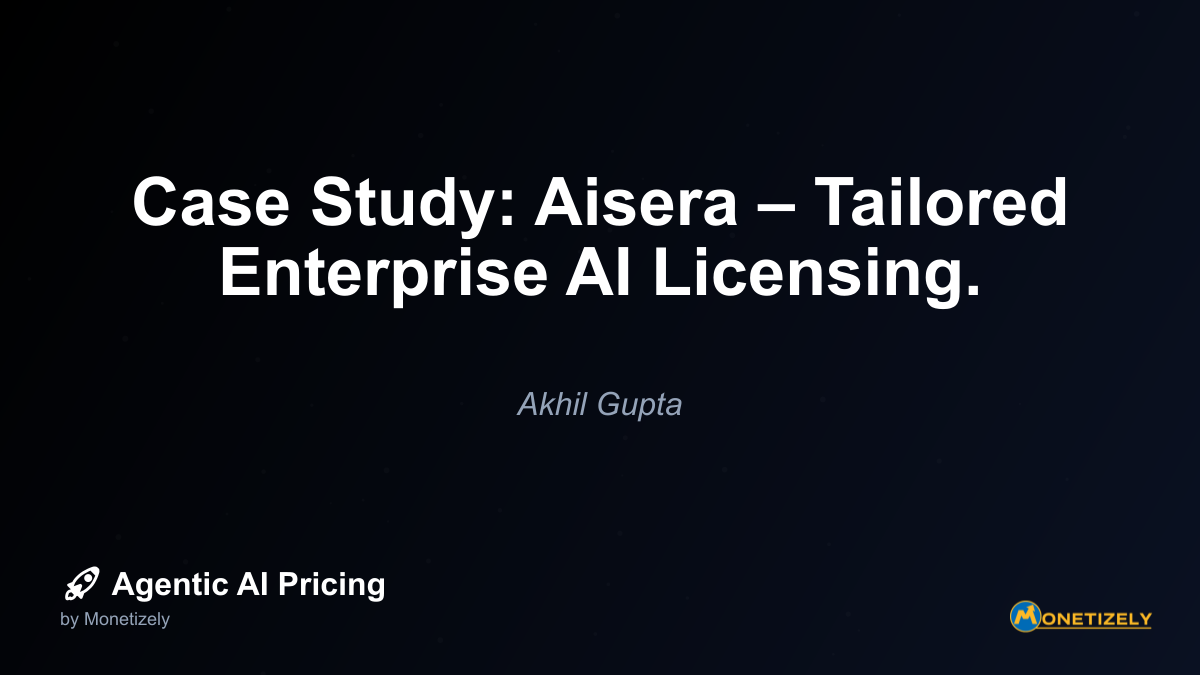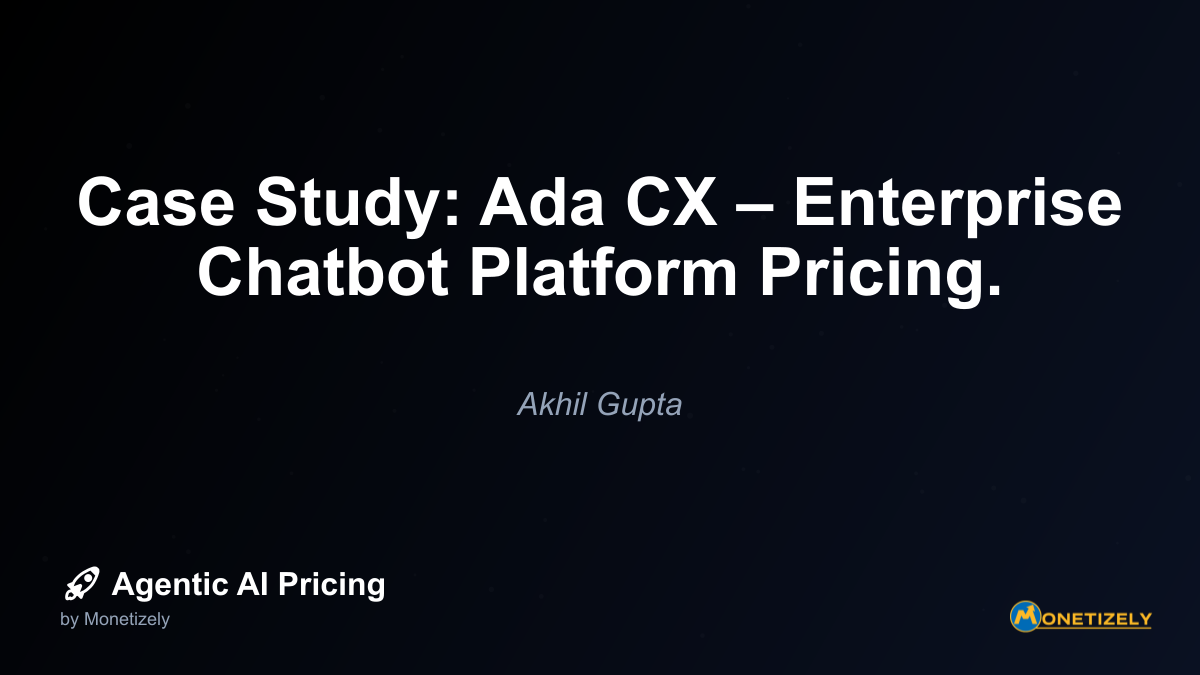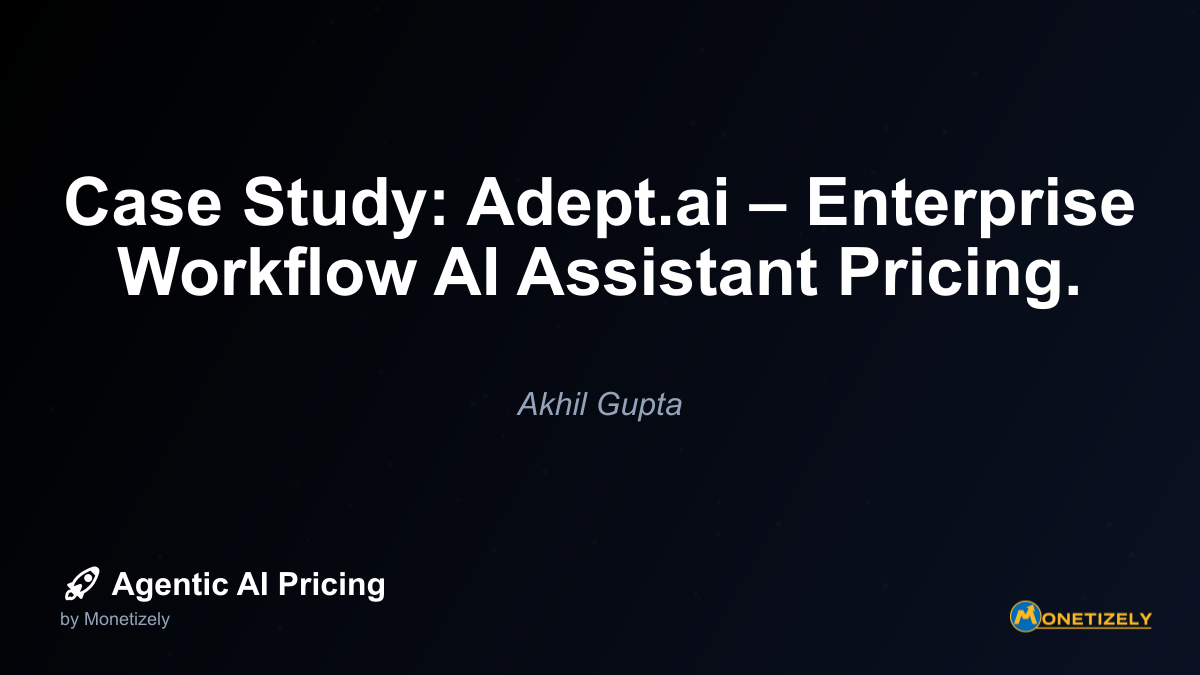· Akhil Gupta · Case Studies · 13 min read
Case Study: Salesforce Agentforce – Multi-Tier Pricing Model Evolution.
AI and SaaS Pricing Masterclass
Learn the art of strategic pricing directly from industry experts. Our comprehensive course provides frameworks and methodologies for optimizing your pricing strategy in the evolving AI landscape. Earn a professional certification that can be imported directly to your LinkedIn profile.

As Salesforce’s AI strategy evolved from its early Einstein days to the sophisticated Agentforce platform, its pricing model underwent a parallel transformation that reflects broader trends in the AI and SaaS industries. This evolution serves as an instructive case study in how companies can adapt their monetization approaches to match technological advancements, market demands, and customer needs.
The Evolution of Salesforce’s AI Pricing Strategy
Phase 1: Einstein Era (2016-2023) - Traditional Add-on Pricing
When Salesforce first introduced Einstein in 2016, it positioned AI capabilities as premium add-ons to its existing cloud products. This initial approach followed a traditional SaaS pricing model:
- Per-user subscription pricing: Typically $50 per user per month on top of existing Salesforce licenses
- Feature-based tiering: Different AI capabilities (Lead Scoring, Opportunity Scoring, etc.) available at different price points
- Limited AI credit allocation: Users received a fixed number of AI-powered predictions or interactions
This model worked well for introducing AI to enterprise customers who were already comfortable with seat-based licensing. However, it created barriers for broader adoption, particularly for smaller organizations or those wanting to experiment with AI without significant upfront investment.
“The early Einstein pricing reflected Salesforce’s premium enterprise positioning,” notes industry analyst Maya Rodriguez. “By bundling AI as an add-on, they could upsell enhanced capabilities to established customers while maintaining their core revenue model.”
Phase 2: Einstein GPT Transition (2023-2024) - Hybrid Consumption Elements
With the launch of Einstein GPT in 2023, Salesforce began incorporating generative AI capabilities into its platform. This technological shift necessitated changes to the pricing approach:
- GPT credit models: Limited generative task credits included in Enterprise add-ons
- Unlimited credits in premium tiers: Higher-priced Unlimited editions included unrestricted AI usage
- Continued user-based foundation: Still primarily tied to per-user licensing
This transitional model acknowledged the higher computing costs associated with generative AI while maintaining the familiar subscription structure customers expected. However, it still presented challenges for organizations wanting to deploy AI broadly without licensing every potential user.
Phase 3: Agentforce Introduction (2025) - Multi-Tier Flexibility
By 2025, Salesforce had rebranded its AI offerings under the Agentforce name and introduced a revolutionary multi-tier pricing approach that fundamentally changed how customers could access and pay for AI capabilities:
- Conversation-based fees: A simple $2 per conversation model that charged only for actual AI agent interactions
- Flex Credits system: A consumption-based model charging approximately $0.10 per action, with credits purchased in bulk (e.g., 100,000 credits for $500)
- Enterprise per-user licensing: Agentforce 1 Editions at $550 per user per month including unlimited AI usage
This three-pronged approach represented a significant evolution in Salesforce’s pricing strategy, moving from a one-size-fits-all model to a flexible framework that could accommodate different customer needs, usage patterns, and deployment scenarios.
Strategic Considerations Behind the Multi-Tier Pricing Evolution
Salesforce’s shift to a multi-tier pricing model for Agentforce wasn’t merely a tactical adjustment—it represented a strategic response to several key market and technological factors.
Addressing Diverse Customer Segments
The most obvious benefit of the multi-tier approach is its ability to serve different customer segments with appropriately tailored pricing options:
- Small businesses and experimenters: The conversation-based fee structure ($2 per interaction) enabled organizations to start small, with minimal upfront investment and costs directly tied to usage.
- Growing mid-market companies: The Flex Credits system provided the flexibility to scale usage across departments while maintaining cost control through bulk purchasing and allocation.
- Enterprise organizations: The unlimited usage per-user licensing model ($550 per user per month) offered predictability for large-scale deployments and simplified budgeting for organizations rolling out AI across thousands of users.
“Salesforce recognized that AI adoption follows different paths depending on organizational size and maturity,” explains Dr. Amrita Patel, AI pricing consultant. “Their multi-tier strategy creates on-ramps for different customer segments, rather than forcing everyone through the same pricing gate.”
Aligning Costs with Value Creation
The evolution also reflected a deeper understanding of how AI creates value and how customers perceive that value:
- From features to outcomes: Moving away from pricing AI as a feature set toward charging for actual conversations and actions aligned costs more directly with business outcomes.
- Usage-based flexibility: The Flex Credits approach recognized that AI usage varies significantly across organizations and use cases, allowing customers to pay for what they actually use.
- Predictability for enterprise planning: The unlimited usage tier addressed enterprise concerns about unpredictable costs as AI adoption scaled across large organizations.
According to a 2025 survey by Enterprise AI Today, 73% of CIOs cited “unpredictable costs” as their top concern when implementing AI solutions. Salesforce’s multi-tier approach directly addressed this concern by offering options that balanced flexibility with predictability.
Competitive Positioning
Salesforce’s pricing evolution also positioned the company strategically against both traditional enterprise software competitors and newer AI-focused entrants:
- Against Microsoft Copilot: While Microsoft bundled AI capabilities into Microsoft 365 subscriptions (typically $30+ per user per month on top of existing licenses), Salesforce offered more granular options for organizations not ready to commit to full per-user licensing.
- Against pure API providers: Unlike OpenAI and other API-centric providers charging purely by token or processing usage, Salesforce’s conversation and action-based pricing was more intuitive and business-outcome focused.
- Against specialized AI vendors: The enterprise unlimited tier bundled AI with Salesforce’s broader platform capabilities, creating a value proposition that standalone AI vendors struggled to match.
Implementation and Customer Response
The rollout of Salesforce’s multi-tier pricing model wasn’t without challenges. Implementation required significant education for both the sales team and customers to understand which pricing option best fit different scenarios.
Early Adoption Patterns
Initial customer response revealed interesting patterns in how organizations approached the different pricing tiers:
- Conversation-based pricing proved popular for initial pilots and departmental deployments, with 68% of new Agentforce customers starting with this model according to Salesforce’s Q3 2025 earnings call.
- Flex Credits gained traction with mid-sized organizations and those with variable usage patterns, particularly in sectors like retail and financial services where AI usage fluctuated seasonally.
- Enterprise licensing was favored by large organizations already heavily invested in the Salesforce ecosystem, with 85% of Fortune 500 Salesforce customers eventually migrating to this model after initial pilots with other tiers.
“We started with the conversation-based pricing to prove the concept within our customer service team,” explains Maria Chen, CIO of Pacific Northwest Insurance. “Once we saw the ROI—a 42% reduction in case handling time—we moved to the enterprise licensing model to roll out Agentforce across all customer-facing departments.”
Implementation Challenges
The multi-tier approach created several implementation challenges that both Salesforce and its customers had to navigate:
- Complexity in forecasting: Organizations struggled to predict which pricing model would be most cost-effective without historical usage data.
- Integration with existing processes: Each pricing tier required different approaches to budgeting, cost allocation, and ROI measurement.
- Migration between tiers: As usage evolved, customers needed clear pathways to transition between pricing models without disruption.
Salesforce addressed these challenges by developing tools to help customers simulate costs under different pricing scenarios and by offering flexible contracts that allowed organizations to shift between pricing tiers as their needs evolved.
ROI and Value Metrics
The success of Salesforce’s multi-tier pricing strategy can be measured through several key metrics that demonstrate its effectiveness in driving adoption and delivering value.
Customer Acquisition and Expansion
By early 2025, Salesforce had signed 5,000 Agentforce deals, with 3,000 paid customers and 2,000 in trial phases. This rapid adoption was facilitated by the flexible pricing approach that reduced barriers to entry.
More importantly, the multi-tier strategy created a natural expansion path:
- 45% of customers who started with conversation-based pricing upgraded to either Flex Credits or enterprise licensing within 12 months
- 62% of Flex Credits customers increased their credit purchases quarter-over-quarter
- Enterprise license customers expanded their user counts by an average of 35% annually
Value Realization
Across different pricing tiers, customers reported significant business value from Agentforce implementation:
- Conversation-based tier: Average cost savings of $12-18 per customer service interaction when compared to human-only handling
- Flex Credits tier: 27% increase in sales team productivity through automated follow-ups and lead qualification
- Enterprise licensing tier: 42% reduction in customer churn through proactive AI-powered engagement
“The flexibility to choose a pricing model that matched our maturity and needs was crucial,” notes Thomas Williams, Chief Digital Officer at Global Retail Partners. “We started with conversation-based pricing for our customer service use case, then expanded to Flex Credits as we identified opportunities in marketing and sales. The ROI has been clear at each stage, which made it easy to justify the continued investment.”
Lessons for AI Pricing Strategy
Salesforce’s evolution from a simple add-on model to a sophisticated multi-tier pricing framework offers valuable lessons for any organization developing pricing strategies for AI products.
Align Pricing with Value Delivery
The most fundamental lesson is the importance of aligning pricing with how customers derive value from AI:
- Identify value units: Determine the most relevant unit of value for your AI solution (conversations, actions, outcomes) and build pricing around it
- Match pricing to customer maturity: Different customers will be at different stages of AI adoption—pricing should accommodate this spectrum
- Create clear ROI paths: Each pricing tier should have a straightforward path to demonstrating return on investment
“The shift from a flat per-conversation fee to charging per AI action helps tie costs directly to business value,” explains pricing strategist James Morrison. “By charging roughly $0.10 per meaningful action, Salesforce avoids charging for ‘fluff’ interactions and better reflects the actual workload of AI agents.”
Build Flexibility and Scalability
Effective AI pricing strategies must accommodate both initial experimentation and enterprise-scale deployment:
- Low-risk entry points: Create pricing options that allow for experimentation without significant upfront investment
- Smooth scaling paths: As usage grows, pricing should scale in a predictable and fair manner
- Enterprise predictability: For large-scale deployments, offer options that provide cost certainty and simplify budgeting
Salesforce addressed these needs by introducing digital wallets that allowed customers to allocate Flex Credits by department or use case, enabling incremental scaling and experimentation across business units.
Balance Simplicity and Sophistication
While AI pricing models can become complex, they must remain understandable to decision-makers:
- Intuitive value metrics: Use pricing units that business leaders can easily connect to outcomes (conversations, actions, resolutions)
- Transparent calculations: Make it clear how costs accrue and what drives pricing
- Predictable forecasting: Provide tools and frameworks to help customers forecast costs under different usage scenarios
According to a 2025 survey, 90% of CTOs and CIOs cited expense management as a hurdle to realizing AI value. Salesforce’s introduction of bundles, tiers, and predictable usage thresholds helped reduce this barrier.
A Framework for AI Pricing Model Selection
Based on Salesforce’s experience and broader industry trends, we can construct a framework to help organizations select the most appropriate pricing model for their AI agent solutions.
Decision Criteria
Usage Pattern & Volume
- Evaluate expected AI agent interaction volume
- Determine if usage will be steady or variable
- For predictable, moderate volume: subscription or fixed per-user licensing
- For variable or high-volume usage: consumption or credit-based models
Cost Predictability vs. Flexibility
- Fixed or per-user seat pricing offers high cost predictability
- Usage-based and outcome-based pricing align costs with actual workload but introduce variability
- Consider hybrid approaches that blend predictability and scalability
Business Outcome Alignment
- Models linking pricing to completed tasks or resolutions tightly couple cost to value
- Consider if measurable business outcomes can be reliably tracked and correlated to AI actions
Scalability Needs
- If AI adoption will scale rapidly, per-user subscriptions with unlimited usage may simplify expansion
- Ensure consumption models include volume discounts or flexible credit reallocation
Integration and Feature Requirements
- Platforms offering bundled support, integration, and updates provide additional value
- Confirm which pricing tiers include required AI capabilities and security standards
Evaluation Metrics
To compare different pricing models effectively, organizations should consider:
- Total Cost of Ownership (TCO): Calculate all expected costs over the contract term under different usage scenarios
- Cost per AI Interaction or Action: Normalize cost by core unit (conversation, API call, task completed)
- Return on Investment (ROI): Quantify potential savings or revenue impacts from AI agent automation
- Flexibility and Scalability Index: Rate how easily each pricing model adapts to changing business needs
- Risk and Budget Variance: Assess financial risks due to cost fluctuations in usage or outcome uncertainty
Pricing Model Comparison
| Pricing Model | Best For | Pros | Cons |
|---|---|---|---|
| Per Conversation | Pilots, low-volume use cases | Simple to understand, low entry barrier | Can become expensive at scale, costs may be unpredictable |
| Flex Credits (per action) | Mid-market with diverse use cases | Granular control, flexible allocation, volume discounts | Requires usage monitoring, more complex to administer |
| Per-user licensing | Enterprise-wide deployment | Predictable costs, unlimited usage, simpler budgeting | Higher upfront costs, potential for underutilization |
Implementation Best Practices
Organizations implementing AI solutions should consider these best practices derived from Salesforce’s experience:
1. Start with Strategy, Not Technology
Successful AI pricing implementation begins with clear business objectives:
- Define specific use cases and expected outcomes before selecting a pricing model
- Align pricing choices with overall digital transformation strategy
- Identify key performance indicators that will measure success
“Organizations that approach Agentforce implementation with a strategy-first mindset see 3.2x higher ROI than those who start with the technology,” notes a 2025 Salesforce implementation study.
2. Conduct Data and Process Readiness Assessment
AI effectiveness—and therefore pricing value—depends heavily on data quality:
- Audit existing data structures and quality before implementation
- Identify process improvements needed to maximize AI value
- Build data governance frameworks that support AI implementation
According to implementation specialists, data readiness is the single biggest predictor of AI deployment success, with properly prepared organizations achieving full implementation 68% faster.
3. Plan for Pricing Evolution
The most successful organizations view AI pricing as an evolving journey:
- Start with limited-scope pilots using consumption-based pricing
- Gather usage data to inform future pricing decisions
- Plan for transitions between pricing models as adoption matures
“We expected our Agentforce pricing to evolve as we learned more about our usage patterns,” explains Financial Services CIO Robert Jackson. “Starting with conversation-based pricing gave us the data we needed to confidently move to enterprise licensing in year two, saving us over $2 million annually.”
4. Implement Strong Governance and Monitoring
Regardless of pricing model, robust monitoring is essential:
- Establish clear ownership for AI cost management
- Implement dashboards that track usage, costs, and value metrics
- Create governance frameworks that prevent unexpected cost escalation
Organizations with strong AI governance reported 47% fewer cost overruns and 58% higher user satisfaction with AI implementations.
Future Outlook for AI Pricing Models
As AI technology continues to evolve, pricing models will likely follow suit. Several trends are emerging that may shape the future of AI pricing:
Outcome-Based Pricing
The next frontier in AI pricing may be pure outcome-based models that directly tie costs to business results:
- Pricing based on revenue generated or costs saved
- Risk-sharing models where vendors and customers share in success
- Performance-based tiers that adjust pricing based on AI effectiveness
“We’re seeing early experiments with outcome-based pricing for specialized AI applications,” notes pricing expert Dr. Samantha Lee. “For example, some sales AI tools are moving toward charging a percentage of incremental revenue generated rather than per-user or per-action fees.”
Ecosystem Pricing
As AI becomes more integrated into broader technology ecosystems, pricing may evolve to reflect this integration:
- Platform-wide AI entitlements that cover multiple applications
- Cross-product bundles that combine AI with other capabilities
- Ecosystem-based pricing that rewards broader platform adoption
Salesforce’s move toward Agentforce 1 Editions reflects this trend, bundling AI capabilities with broader platform access to encourage ecosystem adoption.
AI Resource Optimization
As computing costs for AI continue to evolve, pricing models may become more sophisticated in how they account for resource utilization:
- Tiered pricing based on model complexity and computing requirements
- Efficiency incentives that reward optimized AI usage
- Shared resource pools that allow organizations to allocate AI computing power flexibly
Conclusion: The Strategic Importance of Flexible AI Pricing
Salesforce’s evolution from a simple add-on pricing model to a sophisticated multi-tier approach for Agentforce demonstrates the strategic importance of pricing in AI adoption and value realization. By offering conversation-based fees, a Flex Credits system, and enterprise per-user licensing, Salesforce created multiple paths for customers to access
Co-Founder & COO
Akhil is an Engineering leader with over 16+ years of experience in building, managing and scaling web-scale, high throughput enterprise applications and teams. He has worked with and led technology teams at FabAlley, BuildSupply and Healthians. He is a graduate from Delhi College of Engineering and UC Berkeley certified CTO.
Pricing Strategy Audit
Let our experts analyze your current pricing strategy and identify opportunities for improvement. Our data-driven assessment will help you unlock untapped revenue potential and optimize your AI pricing approach.




